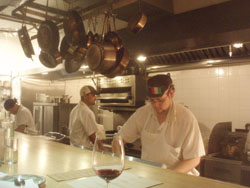Empellón Cocina
 Tuesday, February 21, 2012 at 02:52PM
Tuesday, February 21, 2012 at 02:52PM  Empellón Taqueria had a rocky start when it opened a year ago. The Mexican taco joint from Alex Stupak, the former WD~50 pastry chef, got mixed reviews. I found the food underwhelming and the dining room far too loud.
Empellón Taqueria had a rocky start when it opened a year ago. The Mexican taco joint from Alex Stupak, the former WD~50 pastry chef, got mixed reviews. I found the food underwhelming and the dining room far too loud.
The chef later added sound-proofing, adjusted prices, and broadened the menu beyond tacos. I haven’t been back, but reports I trust suggest that the place is far more enjoyable now than I found it.
Meantime, Stupak has opened a companion restaurant across town, Empellón Cocina, which will offer a more serious, less taco-centric take on Mexican cuisine. The new dining room, while stylistically similar, is just slightly more upscale than the taqueria. There are some odd stylistic choices amidst the minimalist décor: why a crucifix in one corner and a devil statue in the other?
This time, the sound-proofing was installed from the get-go, with fabric walls taking the place of brick in the original joint. Our reservation was early, but the place was full by the time we left, so this was a good test: the sound-proofing works! It’s not a tomb, but you can carry on a conversation.
I’m usually a bit skeptical of Valentine’s Day tasting menus, which often mass-produce a restaurant’s least-interesting food at a hefty premium over the usual price. But at Empellón Cocina, in its first full week of service, I figured I’d get a pretty good sample of the food Stupak will be serving à la carte, and the price was reasonable: $90 for nine courses.
I am running a bit short on time, so I have reproduced the description of the dishes from the hand-out menu, along with my light comments.


The first three dishes were excellent, with strong flavors and a great balance of flavors:
1. Peeky Toe Crab (above left) with Parsnip Juice, Crab Flan and Smoked Cashew Salsa
2. Dry Aged NY Strip Steak (above right) with Crema Parfait, Black Beans and Salsa Roja


3. Melted Tetilla Cheese (above left) with Lobster, Tomate Frito and Kol (Yucatan-style white sauce)
4. Tortilla Soup (above right)
The Melted Cheese with Lobster could become Stupak’s signature dish: it’s excellent. But the tortilla soup was somewhat forgettable.


5. Scallop (above left) with Gachas de Arroz, Plantains and Chilpachole (shellfish broth, epazote, chipotle).
6. Pork Ribs with White Beans Masa Balls, and Green Mole (tomatillo, serrano chile, herbs).
“Did the first chef go home?” That’s what we wanted to know, as the meal fell off a cliff. The poor, delicate scallop was drowned in an unpleasant pool of tomatoey broth; the ribs, served off the bone, were too dry, and served with a humdrum mole.



Stupak is a pastry chef by trade, so you would expect the desserts to be strong—and they were:
7. Rose Meringe (above left) with Cherry Sorbet and Hibscus Yogurt
8. Bonus course (above center); I believe Arroz con Leche, the best of the three
9. Chocolate Cake (above right) with Pineapple and Vanilla Cream
I didn’t take note of the wine that we ordered, but cocktails before dinner were mediocre. My girlfriend asked for something similar to a Cosmopolitan (they couldn’t make one exactly, as they lacked cranberry juice), and got its diametric opposite. Another that I ordered off the menu tasted mostly of tonic water. But the bar staff seemed new and will undoubtedly improve; to their credit, they took the non-Cosmo off the bill.
Servers were well versed on the menu, and the food came out at a reasonable pace—neither too fast nor too slow. Of course, the kitchen’s task is easier when they know every diner will have exactly the same things, in exactly the same order. That’s one of the reasons why restaurants limit your choices on Valentine’s Day.
If Stupak’s track record at Empellón Taqueria is any guide, Empellón Cocina will get better over time. On a Valentine’s Day tasting menu, one week in, he batted .500 on the savory courses and 1.000 on the desserts. That is a pretty good start.
Empellón Cocina (105 First Avenue between E. 6th & E. 7th Streets, East Village)
Food: *½
Service: *½
Ambiance: *½
Overall: *½















































